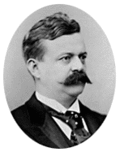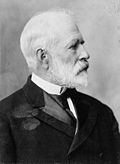Top Qs
Timeline
Chat
Perspective
1897 New York City mayoral election
1st election after New York City's consolidation From Wikipedia, the free encyclopedia
Remove ads
An election for Mayor of New York City was held in November 1897. This election was held in connection with the consolidation of the City of Greater New York, which passed a public referendum on December 14, 1894, and was to be effective January 1, 1898. Thus, the winner of this election would serve as the first mayor of the consolidated city.
Incumbent mayor William L. Strong was not a candidate for re-election to a second term in office. The multipolar race featured chief justice of the City Court Robert A. Van Wyck, Columbia University president Seth Low, former U.S. secretary of the Navy Benjamin F. Tracy, and tax reformer Henry George. On October 29, just a few days before the election, George died. Van Wyck won the race with a plurality of the vote, followed by Low and Tracy.
Remove ads
Background
On December 14, 1894, the voters in the towns of New York County (then coterminous with New York City and consisting of two boroughs, Manhattan and the Bronx), Kings County (consisting entirely of the consolidated city of Brooklyn), Richmond County, and Queens County voted to consolidate into one city with a unified municipal government. The city also annexed parts of southern Westchester County. The enlarged city would contain the majority of the state of New York's population.
To allow for the consolidation to take effect on January 1, 1898, the term of mayor William Lafayette Strong was extended by a year, and the next mayoral election was moved from 1896 to 1897.
Remove ads
General election
Candidates
- Alfred B. Cruikshank[1] (United Democracy)
- Henry George, political economist and tax reformer (Jeffersonian Democracy) (died October 29)
- Patrick Gleason, mayor of Long Island City[2] (Independent)
- Seth Low, president of Columbia University and former mayor of Brooklyn (Citizens Union)
- Lucien Sanial, newspaper editor, economist, and activist (Socialist Labor)
- Benjamin F. Tracy, former U.S. Secretary of the Navy and U.S. Attorney for the Eastern District of New York (Republican)
- William T. Wardwell, perennial candidate[3] (Prohibition)
- Robert Anderson Van Wyck, chief justice of the New York City Court (Democratic)
Withdrew
- James O'Brien, former U.S. Representative[1] (United Democracy)
Results
Results by borough
| 1897 | Party | The Bronx and Manhattan | Brooklyn | Queens | Richmond [Staten Is.] | Total | % |
| Robert A. Van Wyck | Democratic | 143,666 | 76,185 | 9,275 | 4,871 | 233,997 | 44.7% |
| 48.0% | 40.1% | 40.7% | 43.5% | ||||
| Seth Low | Citizens' Union | 77,210 | 65,656 | 5,876 | 2,798 | 151,540 | 28.9% |
| 25.8% | 34.6% | 25.8% | 25.0% | ||||
| Benjamin F. Tracy | Republican | 55,834 | 37,611 | 5,639 | 2,779 | 101,863 | 19.5% |
| 18.6% | 19.8% | 24.7% | 24.8% | ||||
| † Henry George | Jefferson Democracy | 13,076 | 6,938 | 1,096 | 583 | 21,693 | 4.1% |
| Lucien Sanial | Socialist Labor | 9,796 | 3,593 | 921 | 157 | 14,467 | 2.8% |
| TOTAL | 299,582 | 189,983 | 22,807 | 11,188 | 523,560 |
Remove ads
Notes
- Incomplete results from the New York Times are included for the Prohibition, United Democracy, and Gleason tickets.
References
Sources
Wikiwand - on
Seamless Wikipedia browsing. On steroids.
Remove ads



